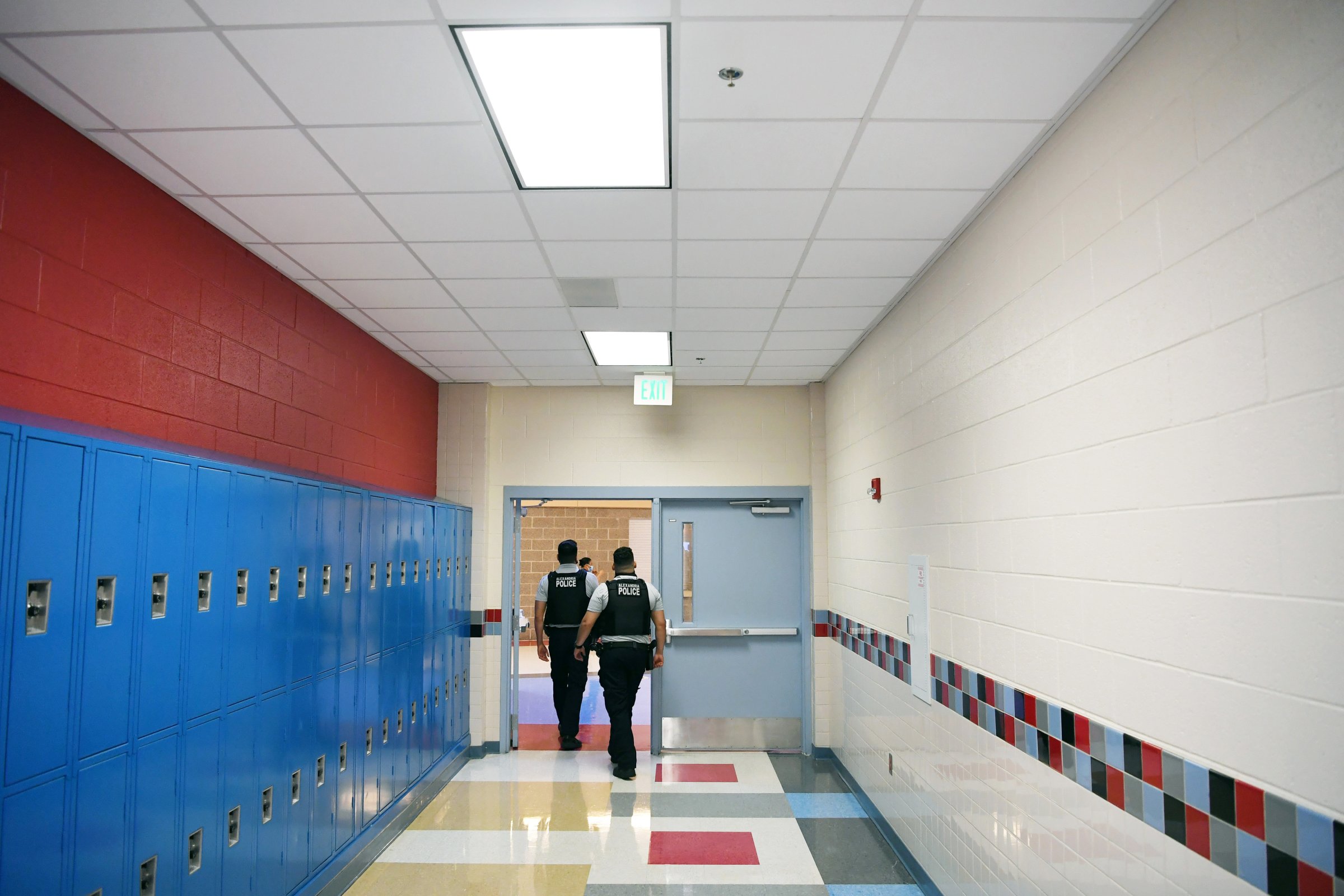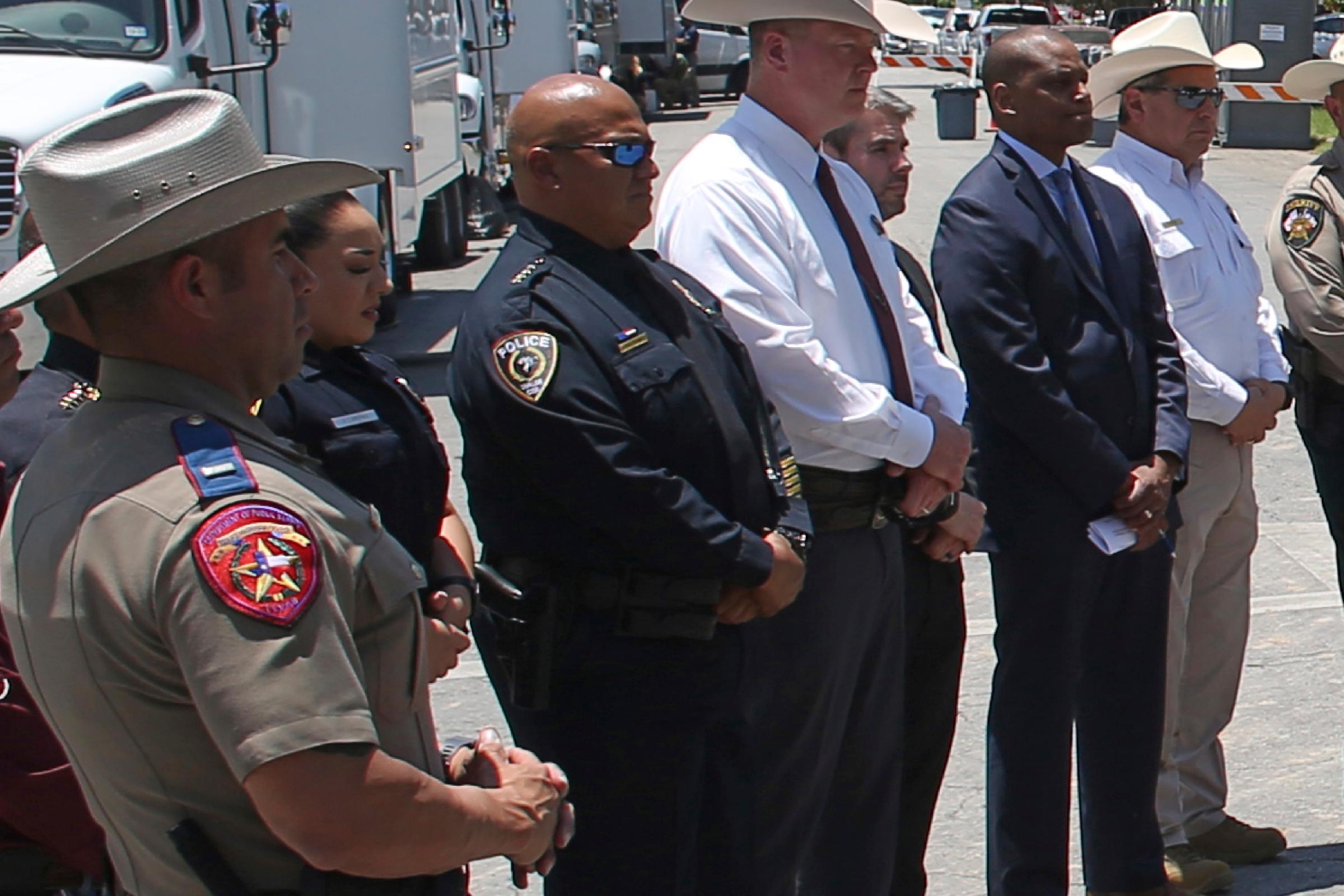
The calls to put more armed officers into schools across the country came swiftly after 19 children and two teachers were shot and killed in Uvalde, Texas on May 24.
Texas Gov. Greg Abbott encouraged schools to increase the presence of law enforcement officers on campus, and the superintendent of the Uvalde school district said he plans to do just that this fall. In Kentucky, hundreds more school resource officers (SROs) will need to be hired before August to accommodate a new state law that requires there to be an SRO on every K-12 campus in the state. And the National Association of School Resource Officers (NASRO), which trains school-based officers, is advocating for “every school at every level” to have a trained school resource officer on campus whenever school is in session.
Mo Canady, executive director of NASRO, says responding to school shootings is “a critical part of the job” for school resource officers. “When that comes to visit a school, there’s nothing more important for the SRO to be engaged in,” he says.
But the trend of putting more armed police officers on campuses in response to school shootings has come even though it’s not clear that the presence of an SRO makes a mass shooting on campus less likely. And the latest push comes despite the failure of armed officers to stop the gunman in Uvalde. The school police response there has become a national scandal.
An ‘abject failure’ in Uvalde

In testimony before a Texas state Senate committee on Tuesday, Steven McCraw, director of the Texas Department of Public Safety, called the police response to the Uvalde shooting “an abject failure.” Officers at the school waited over an hour to enter the classrooms and confront the gunman—a decision that was “antithetical to everything we have learned over the last two decades since the Columbine massacre” in 1999, McCraw said.
Best practices call for responding officers to first “stop the killing,” and move in to confront the attacker as soon as possible. Officers should “immediately move into action to isolate, distract or neutralize the threat, even if that means one officer acting alone,” according to an active-shooter training by the Texas Commission on Law Enforcement.
McCraw placed the blame squarely on the school district’s police chief, Pete Arredondo, whom he identified as the on-scene commander during the shooting. McCraw said three minutes after the gunman entered the building, there were enough armed officers wearing body armor “to isolate, distract and neutralize the subject.” But instead, officers waited one hour and 14 minutes to enter the classroom and kill the gunman.
“The only thing stopping a hallway of dedicated officers from entering Room 111 and 112 was the on-scene commander, who decided to place the lives of officers before the lives of children,” McCraw said Tuesday. “The officers had weapons; the children had none. The officers had body armor; the children had none. The officers had training; the subject had none.”
Eight Uvalde Police Department officers and three members of the Uvalde Consolidated Independent School District Police Department, including Arredondo, entered the school building three minutes after the gunman, according to a timeline shared by McCraw on Tuesday.
McCraw faulted Arredondo for waiting for the arrival of a radio, rifles, shields, a SWAT team, and “a key that was never needed,” alleging that the classroom door was unlocked all along, but no one had checked.
Arredondo defended his response and contradicted some of McCraw’s assertions in a recent interview with the Texas Tribune. He said he did not consider himself the incident commander and didn’t “issue any orders” telling officers not to breach the building. He told the Tribune that the classroom door was locked and could not be kicked in, as he tried “dozens” of keys to unlock it. A lawyer for Arredondo did not immediately respond to TIME’s request for comment on Wednesday.
The Uvalde school superintendent placed Arredondo on administrative leave on Wednesday, while the district awaits the results of an investigation into the shooting response.
Canady says that NASRO had trained officers in the Uvalde district in the past, but he doesn’t know if that included officers who responded to the shooting at Robb Elementary. He says it’s possible that best practices weren’t followed by officers during the shooting response, but he doesn’t have enough details yet to assess what happened in Uvalde.
More armed police and more school shootings
About 51% of schools had a sworn law enforcement officer routinely carrying a firearm in the 2019-20 school year, up from 43% in the 2015-16 school year, according to data from the National Center for Education Statistics. And 65% of public schools had one or more security guard on campus during the 2019-20 school year, up from about 42% of schools in 2005-06. The 2018 shooting at Marjory Stoneman Douglas High School in Parkland, Fla., led to more calls for armed officers and even armed teachers at schools.
Meanwhile, the number of shootings with casualties at K-12 schools has increased since the 2012-13 school year—when there were 22 shootings, including the deadly attack at Sandy Hook Elementary School—and reached 93 shootings in 2020-21, according to the National Center for Education Statistics.
Canady argues that if SROs are carefully selected and well-trained, they can be a valuable asset to schools. “You’ve got to be prepared that if you hear gunfire in your school, or you hear something else going on, that the switch flips instantly, and that you become the best tactical officer your department can hope to offer,” Canady says. “There’s no one out there that can be perfect in all of those roles. But we’re looking for the best that we can get.”
But training aside, it’s not clear that school resource officers actually improve safety. A 2021 article by researchers at Hamline University and Metropolitan State University in Minnesota examined 133 school shootings. The study concluded there was no association between the presence of an armed officer and deterrence of violence, noting that most school shooters are students themselves, which raises questions about whether increasing school security is an effective preventative tool.
READ MORE: Schools Are Spending Billions on Safety Measures to Stop Mass Shootings. It’s Not Clear They Work
Indeed, an SRO was on campus during the school shooting in Parkland, where 17 people were killed, but failed to stop the gunman. Later in 2018, two police officers stationed at Santa Fe High School in Texas, were praised for their bravery after they confronted a school shooter and cornered him within four minutes. Still, eight students and two staff members were killed.
“We must face the truth—more militarized school environments do not address the root causes of mass violence,” Andrew Hairston, Education Justice Project Director for Texas Appleseed, said in a statement after the Uvalde shooting.
Canady points to other examples of officers stopping school shooters—including a 2018 shooting at Great Mills High School in Maryland, in which the gunman died by suicide during a confrontation with a school resource officer after killing one student and injuring another. During another incident in 2018, a police officer in Dixon, Illinois, shot and wounded a gunman who opened fire at a high school graduation rehearsal and then fled the building.
‘A Herculean task’
Not all schools are focused on adding police officers. In the wake of the 2020 murder of George Floyd, schools from Minneapolis to Portland, Ore., removed officers from campus, responding to concerns about over-policing, particularly for Black students.
Jeff Godown, who was the school police chief in Oakland, Calif., supported a vote by the school board, inspired by years of community activism, to eliminate his department—and his job—in June 2020.
Today, Godown still thinks it’s not necessary to have armed officers patrolling school hallways, dealing with day-to-day discipline issues. He understands if parents or teachers would feel more comfortable having an officer stand guard outside a school, but he worries that it’s not a realistic or affordable solution.
“Are you telling me that we need an armed police officer at every school—elementary and middle school—in the United States of America?” says Godown, who is now the interim police chief of California State University, San Bernardino. “That would be a Herculean task to have that many officers assigned to those schools.”
He says it’s a mistake to put all the responsibility on SROs and on school “hardening” efforts, without also addressing access to assault rifles used by the gunmen in Uvalde and Parkland. “I see no need for that gun in circulation for a civilian population,” he says, noting that the use of such weapons creates additional challenges for responding officers, who are likely armed with only a handgun.
“Most of these people that come into the schools are heavily armed, such as in this case, and sometimes the officers are out-gunned from the word Go,” Godown says. “They’re going to be the first line of defense,” he says, of school resource officers. “But you can’t expect them to be the only line of defense.”
More Must-Reads from TIME
- Cybersecurity Experts Are Sounding the Alarm on DOGE
- Meet the 2025 Women of the Year
- The Harsh Truth About Disability Inclusion
- Why Do More Young Adults Have Cancer?
- Colman Domingo Leads With Radical Love
- How to Get Better at Doing Things Alone
- Michelle Zauner Stares Down the Darkness
Write to Katie Reilly at Katie.Reilly@time.com